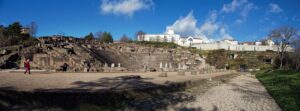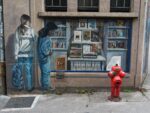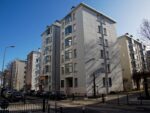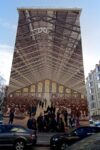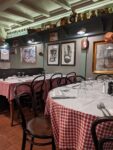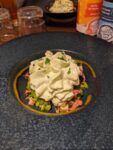To download a printable PDF version (no pictures)
click on this link E2E2023no1.pdf (four A4 pages)
There is a gallery of some photographs of Lyon
including a gallery of the frescoes we saw
There are also clickable links in the text
Depressing leaden skies, muddy footpaths and puddles. The last of January’s festivities, galette des rois, champagne, dancing and lunch for the village elderly had taken place. Dull damp days lay ahead. We have never visited Lyon, so, on the spur of the moment, on Sunday, we researched hotels, packed clothes and set out to drive southwards through Monday’s snow showers for a change of scenery. We were also to benefit from a change of weather, for, although it remained cold, the sunshine was invigorating.
We soon realised that our knees are not what they used to be. We had decided to work our way through Lyon’s history, and, of course, history starts with the Romans. One of the Roman sites in Lyon, Lugdunum, lies on the Fourvière hill above the Rhone and Saône. Fortunately the strike of some transport workers on that first full day, Tuesday, only slightly slowed our journey across town from our hotel by tram, metros and one of the two funiculars. We still take a childish pleasure in funicular rides. As we emerged from the tunnel, the expanse of the Roman theatre (the oldest in France) and adjacent odeon amazed us. Bright winter sunshine lit up the tiers of seats, and as we paused on our steep ascent of the amphitheatre and turned round, the concrete offices and apartments of modern Lyon basked in a soft lemon light below us. The brutalist concrete site museum buried in the hillside was as dramatic as the amphitheatre, and the finds of urns, sarcophagi, bronze inscriptions and mosaics were perfectly at home beneath the museum’s soaring concrete columns and arches.
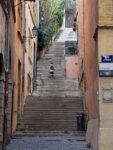 From the museum we walked up towards the Basilica Notre-Dame-de-Fourvière, searching, in vain, for coffee. The glittering mosaics of the basilica and a metal tower (an imitation of the Eiffel Tower) were no compensation for the lack of refreshments, apart from a very expensive restaurant. To add insult to injury, the other funicular station was closed, we assumed as part of the strike. So we set out to walk down the hill to the old town and its cafés. Our ageing knees soon gave way on a long steep flight of steps. When we finally got to the bottom of the hill, we sank gratefully onto chairs in a coffee shop in one of the fine renaissance buildings on Rue de Boeuf. Later, on the metro, we heard an announcement that funicular F2 line was closed because of a “technical incident”. The next day we noticed that the central cable had been removed, which would account for the lack of service!
From the museum we walked up towards the Basilica Notre-Dame-de-Fourvière, searching, in vain, for coffee. The glittering mosaics of the basilica and a metal tower (an imitation of the Eiffel Tower) were no compensation for the lack of refreshments, apart from a very expensive restaurant. To add insult to injury, the other funicular station was closed, we assumed as part of the strike. So we set out to walk down the hill to the old town and its cafés. Our ageing knees soon gave way on a long steep flight of steps. When we finally got to the bottom of the hill, we sank gratefully onto chairs in a coffee shop in one of the fine renaissance buildings on Rue de Boeuf. Later, on the metro, we heard an announcement that funicular F2 line was closed because of a “technical incident”. The next day we noticed that the central cable had been removed, which would account for the lack of service!
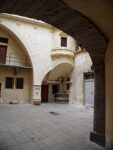 On the second day, Wednesday, we explored the mediaeval and renaissance streets of the silk merchants in the old town at the foot of the Fourvière hill, with their enticing narrow, covered passageways (traboules) and courtyards behind heavy doors. We wandered into the renaissance buildings and hillside gardens of the powerful Gadagni Florentine bankers. A restored clock, l’horloge aux guignols, had been re-installed there and we watched the two puppets striking the hour. We continued along the Rue Juiverie from which the Jews had been expelled in the fourteenth century to be succeeded by wealthy Italian merchants and bankers. And suddenly we were at the incongruous small St Paul railway station. The enticing aromas from the bakery opposite the station lured us in for large pastries (savoury and sweet) and glasses of milky coffee. We walked on, drawn into St Paul’s church by the sweet recorded music. In an alley, we were accosted by a smoking restaurant worker who insisted that we should cross the footbridge over the Saône to the Presqu’ile and see the famous Fresque des Lyonnais.
On the second day, Wednesday, we explored the mediaeval and renaissance streets of the silk merchants in the old town at the foot of the Fourvière hill, with their enticing narrow, covered passageways (traboules) and courtyards behind heavy doors. We wandered into the renaissance buildings and hillside gardens of the powerful Gadagni Florentine bankers. A restored clock, l’horloge aux guignols, had been re-installed there and we watched the two puppets striking the hour. We continued along the Rue Juiverie from which the Jews had been expelled in the fourteenth century to be succeeded by wealthy Italian merchants and bankers. And suddenly we were at the incongruous small St Paul railway station. The enticing aromas from the bakery opposite the station lured us in for large pastries (savoury and sweet) and glasses of milky coffee. We walked on, drawn into St Paul’s church by the sweet recorded music. In an alley, we were accosted by a smoking restaurant worker who insisted that we should cross the footbridge over the Saône to the Presqu’ile and see the famous Fresque des Lyonnais.
Our first glimpse was of a charming bookshop painted on a ground floor wall, but rounding the corner of the building, seven stunning storeys of painted wall opened up showing over thirty famous Lyonnais characters, including the Emperor Claude, the cinematographers Auguste and Louis Lumière, author Antoine de Saint Exupery and his Petit Prince, and chef Paul Bocuse. We returned to the old town to see the gothic cathedral of St Jean. Our explorations ended in the huge Place Bellecour, with its big wheel and its stalwart naked stone warrior guarding the plaque to resistance members shot there in 1944 by the Gestapo (whose headquarters were close). From there we caught the metro and then tram back to our hotel.
Our apartment hotel (Otelia Gestetud) was in a modern block on the T2 tram route; there were few shops or restaurants nearby, but a large number of funeral parlours which were handy for the two large cemeteries and crematorium de la Guillotière on either side of the railway line. This may sound a grim location, but we found the hotel well staffed and equipped, clean and comfortable, and with parking below. At the beginning of the twentieth century the cemeteries lay on the edge of the city, with fields and farmland beyond. A forward-looking mayor and a local architect, Tony Garnier, who had visions of the Cité idéale with its separate industrial, hospital and hygienic housing areas, planned a large housing estate here in what became known in 1917 (after America’s entry in the war) as the États-Unis district. We decided to spend our last morning looking at the flats which (like social housing schemes in the UK) were so innovative for their first residents in the thirties. They have since been renovated, and in the nineties striking paintings were added to their blank end walls.
In addition to the Fresque des Lyonnais which we had seen the previous day, we had also enjoyed the three striking frescoes of the Tower of Babel just beyond out hotel, so on Thursday we walked from Babel down the Boulevard des États-Unis to the Shanghai frescoes and then on to the wall paintings of the Cité idéale. The five-storey apartment blocks looked spacious, with their large balconies and garden walkways. They were originally designed as two-storey buildings but the mayor insisted the design was changed to four storeys and then sometime later another storey was added. The paintings on their end walls showed Tony Garnier’s plans and illustrations of his ideal city, and ideal cities in Egypt, India, Mexico, Quebec, the USA and the Ivory Coast by other artists. At the end of the development was a small park with attractively engraved quotations about resistance and liberty. Then, unexpectedly, we were in a thronging covered market, bright with shiny peppers, tomatoes, and colourful headscarves.
The T6 tram from the market passed the huge iron, glass and concrete abattoir created in 1914 by Tony Garnier. We had seen its airy interior depicted on one of the murals, with Lyon dignitaries and impeccably clean cattle (not a cow pat in sight). After falling into lengthy disuse, it was restored and is now used for concerts and sporting events. We also paused to look at frescoes commemorating the Mexican artist Diego Rivera, before catching a T1 tram across a curving bridge to the Musée des Confluences.
Appropriately for a museum which included natural history exhibits like a mammoth skeleton and dinosaur eggs, the striking modern building looked from a certain angle like a crouching armour-plated prehistoric animal. We wandered through displays of juxtaposed artefacts from different times and places (bewildering for those of us who like our history to be chronological rather than thematic “magic” “eternities” or “societies: the human theatre”).
On the way back to our hotel, we looked at more of the frescoes on the other side of the Boulevard des Etats Unis and stopped at the tiny Musée urbain Tony Garnier which was now open, but our legs were by now too weary to linger too long over the fascinating twentieth century artefacts and film footage. We were glad to put our feet up in our hotel room before setting out for our last evening meal in Lyon.
Lyon is noted for its famous chefs and restaurants, but our trip was too last-minute to allow for booking any of them. Nevertheless, we enjoyed some varied meals. Many restaurants in France are closed on Monday so the choice was even more limited on our first evening. We walked into the Part-Dieu quarter north of our hotel, to the Asmara Eritrean restaurant, where we ate with our fingers, rolling assorted specialities in torn-off bits of injera (sour dough pancake).
As all the trams were due to stop running at 20:30 on the second evening due to strikes, John bravely drove us to the old town through Lyon’s rush-hour busy streets. At one of the touristy bouchons (traditional Lyonnaise cuisine restaurants), Daniel et Denise, Helen was delighted to find old-fashioned red-and-cream checked tablecloths, and we ate traditional dishes like the pâté en croûte starter (which looks so like pork pie) and our main course of roast pork pluma and black sausage with roast potatoes and macaroni cheese, followed by apple Tarte Tatin or chocolate dessert. The following evening, groups of diners shivered outside the slightly more up-market Table 101 until Madame deigned to let us in. But the food was beautifully cooked and presented, so all was forgiven as we ate our way through a superior pâté en croûte or some dainty snail and sweetbread ravioli, followed by sturgeon or veal and then fancy desserts.
The meals seemed to get better each evening, culminating at the Poivron Bleu. Helen thought this was going to be a posh place, but it turned out to be more of a convivial narrow passageway running back into the narrow kitchen, with two enthusiastic waiters and a chalkboard menu. Imagine the best prawn cocktail, substitute octopus, chick peas and lemon and curry gel for the prawns, and that was our salade de poulpe starter. The pork main course was delicious, and the desserts too. One of the waiters made a point of giving a long description of the making of the lemon cake dessert to everyone apart from us (why not us?) Was he also its proud creator? Chef rather than waiter?
It seemed a shame to leave on that sunny Friday morning. But we were given a reminder of places we had seen, as our satnav guided us along streets through the city centre which we had seen in the dark from trams and buses, then plunged us into a long tunnel (1.15 miles) all the way under the Roman remains on the Fourvière hill. The petrol station we were heading to closed as we got there (presumably for a petrol delivery), so we saw more of the far side of the hill before filling up elsewhere and joining the A6. As we drove northwards, the skies got greyer, and, would you believe it, the moment we passed sign announcing that we were back in our region, the Grand Est, the drizzle started.
However, the good news is that, during our absence, a young-looking (over a year old) male kestrel has returned to inspect their old quarters on the attic window sill. We have not previously seen one as early as January. So John is having to rush to reinstall their balcony extension and put the second camera in a better position. He thought he had a month or more ahead for renovation works!

